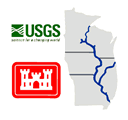LTRMP Technical Report 2010–T001
 Evaluation of Light Penetration on Navigation Pools 8 and 13 of the Upper Mississippi River
Evaluation of Light Penetration on Navigation Pools 8 and 13 of the Upper Mississippi River
Abstract
The availability of light can have a dramatic affect on macrophyte and phytoplankton abundance in virtually all aquatic ecosystems. The Long Term Resource Monitoring Program and other monitoring programs often measure factors that affect light extinction (nonvolatile suspended solids, volatile suspended solids, and chlorophyll) and correlates of light extinction (turbidity and Secchi depth), but rarely do they directly measure light extinction. Data on light extinction, Secchi depth, transparency tube, turbidity, total suspended solids, and volatile suspended solids were collected during summer 2003 on Pools 8 and 13 of the Upper Mississippi River. Regressions were developed to predict light extinction based upon Secchi depth, transparency tube, turbidity, and total suspended solids. Transparency tube, Secchi depth, and turbidity all showed strong relations with light extinction and can effectively predict light extinction. Total suspended solids did not show as strong a relation to light extinction. Volatile suspended solids had a greater affect on light extinction than nonvolatile suspended solids. The data were compared to recommended criteria established for light extinction, Secchi depth, total suspended solids, and turbidity by the Upper Mississippi River Conservation Committee to sustain submersed aquatic vegetation in the Upper Mississippi River. During the study period, the average condition in Pool 8 met or exceeded all of the criteria whereas the average condition in Pool 13 failed to meet any of the criteria. This report provides river managers with an effective tool to predict light extinction based upon readily available data. |
Revised September 13, 2010 Posted July 15, 2010 For additional information contact: Part or all of this report is presented in Portable Document Format (PDF); the latest version of Adobe Reader or similar software is required to view it. Download the latest version of Adobe Reader, free of charge. |
Giblin, Shawn, Hoff, Kraig, Fischer, Jim, and Dukerschein, Terry, 2010, Evaluation of light penetration on Navigation Pools 8 and 13 of the Upper Mississippi River: U.S. Geological Survey Long Term Resource Monitoring Program Technical Report 2010–T001, 16 p.
Preface
Abstract
Background
Methods
Results and Discussion
Conditions During the Study Period
Historical Comparisons
Comparisons of Water-Quality Parameters to Light Extinction
Comparison of Results to Proposed Water-Quality Criteria
Effects of Tributaries on Light Extinction
Effects of Composition of Suspended Solids on Light Extinction
References Cited